
 |
 |
||||||||
|
|
Lessons Menu - Lesson 9 - Lesson 10 - Lesson 11 - Lesson 12 - Lesson 13 - Lesson 14 - Lesson 15 - Lesson 16 |
| Lesson Plan 14 - Agriculture ADVANCES IN AGRICULTURE |
download
lesson14.pdf |
|
| OVERVIEW STUDENT OBJECTIVES CALIFORNIA HISTORY STANDARDS
BACKGROUND ARTICLE 14
STUDENT ACTIVITY SHEET 14 AND KEY |
ADDITIONAL ITEMS AVAILABLE IN THIS LESSON PLAN: |
|
DOCUMENTS TO DISCUSS
(view online or print screen) |
||||
 view large image |
1. Asparagus cannery [1911] Interior of an asparagus cannery. |
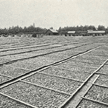 view large image |
2. Drying peaches [1922] Peaches drying on racks. |
|
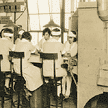 view large image |
3. Sorting almonds [ca. 1920] Six women sort and inspect almonds. Large machines shown are dryers. After being sorted, the almonds continued through another machine. |
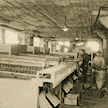 view large image
view large image |
4. Almond processing [ca. 1920s] Interior of Almond Grower's plant showing two men standing next to sorting and cleaning machinery. |
|
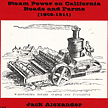 download PDF file
download PDF file |
5. Steam Power
of California [unknown] This booklet illustrates some early steam-powered equipment that was developed by Californians. |
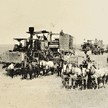 view large image
view large image |
6. Steam harvesters [ca. 1924] Seven steam harvesters with 54 horse teams hauling five tons of hay each. The hay was cut, loaded on barges and on its way 100 miles down stream to the Sperry Flour Mills, all on the same day. |
|
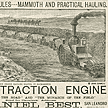 download PDF file
download PDF file |
7. Best's traction
engine [1891] This engraving shows Best's Engine pulling seven carts of gravel in Sacramento. |
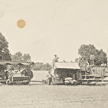 view large image
view large image |
8. Holt tractor and
harvester [ca. 1910] Side view of a Holt-built tractor towing a harvester. Four men (possibly the Sieferman Brothers) and a dog pose on the equipment near Woodland. |
|
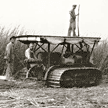 view large image |
9. Mowing tules [ca. 1917] Men operate a mowing tractor in preparation for plowing. The tractor is pulling a large wooden barrel which flattens the tules. One man is on the roof to look out for hazards and holes. |
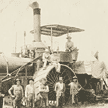 view large image |
10. Steam tractor [ca. 1880s] Ten people pose in front of a steam tractor. |
|
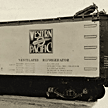 view large image |
11. Refrigerator car [unknown] Pacific Fruit Express refrigeration car No. 50187. |
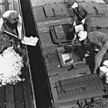 view large image |
12. Icing a refrigerator
car [unknown] Men load ice into Fruit Growers Express refrigerator car. |
|
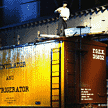 view
large image
view
large image |
13. Icing a refrigerator
car [unknown] Fruit Growers Express car No. 35832 restored to its 1938 appearance, on display at the California State Railroad Museum in Sacramento. |
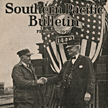 download PDF file
download PDF file |
14. Southern Pacific
Bulletin [1927] This bulletin includes The story of a half-million cakes of ice, an article describing how ice was cut at the Pacific Fruit Express' natural ice plant at Carlin, Nevada, a re-icing station for perishable shipments. |
|
|
INSTRUCTIONS 2. Read Background Article 14. You may wish to read it to your students or have them read it by themselves. Discuss any questions that they may have. 3. Show and discuss Document 1, Asparagus cannery and Document 2, Drying peaches. Tell students that this image shows different ways that people learned to preserve food. What canned and dried fruits and vegetables have they eaten? Have any of their relatives dried or canned fruits or vegetables? If so, what steps did they have to take to do so? What foods would not be available in their community if canning had not been invented? 4. Document 3, Sorting almonds and Document 4, Almond processing. These images show how processing of almonds began to involve machines and assembly lines. However, some of the processing still required tedious hand labor, such as the sorting shown in Document 3. Have your class investigate how almonds are harvested and processed today. 5. Document 5, Steam Power of California. This document illustrates some of the early steam equipment used for harvesting. Identify the purpose of each machine shown. Discuss how farm equipment has changed since 1911. 6. Document 6, Steam harvesters. This image provides a good illustration of the size, horsepower requirements, and weight of steam-powered equipment, as well as the scope of the harvest on a large tract of land. It also illustrates how equipment owners would combine labor and machines to harvest one farm at a time. Have students calculate how many tons of hay the seven harvesters hauled. (35 tons) How many pounds? (70,000) 7. Document 7, Best's traction engine and Document 8, Holt tractor and harvester. Ask students to describe the differences between the traction engines shown. They may note that Best's engine had a distinctive tall boiler, and the example shown for Holt is a track-type crawler. Discuss the pros and cons of different steam engine and tractor designs. Have students suggest other approaches or come up with their own designs that would help keep tractors from sinking in the Delta mud. Compare these tractors to modern tractors. Are any of the features of the modern machines similar to the older equipment? How have they been improved? 8. Document 9, Mowing tules. This image depicts a specialized machine designed to help farmers in the Delta area. Ask students if they have seen tules. Why would these plants grow in the Delta area? (grow in wet areas) 9. Document 10, Steam tractor. This image is another example of a steam tractor showing its size and wide wheels. Based on the students' knowledge of Holt and Best, whose machines do they think this tractor most resembles. (probably those of Best) 10. Document 11, Refrigerator car and Documents 12 and 13, Icing a refrigerator car show refrigeration cars and how they were filled or iced. Read the article The story of a half-million cakes of ice in Document 14, Southern Pacific Bulletin to students or have them read it independently. Assign several students to find out how modern foods are kept cool for shipping and report to the class. 11. Give students Activity Sheet 14: Advances in Agriculture (printed from the PDF file). After they have completed the activity, discuss their answers as a group. FOLLOW-UP 2. Print Document 5, Steam Power of California. Create additional illustrations showing later inventions and bind all the pages into a booklet for the class. 3. Play the role of Best or Holt to sell one of your engine designs to your class.. 4. Identify at least five other sources that might help you identify the specific builder and date of the tractor shown in Document 10, and use the sources to search for the information. 5. In Sacramento, visit the California State Railroad Museum to see a railroad refrigeration car or the Discovery Museum to see Holt and Best steam tractors. REFERENCES AND RESOURCES Blandford, P.W. Old farm tools and machinery: An
illustrated history. Martin, G.A. Farm equipment and hand tools. Murphy, J. Tractors: From yesterday's steam wagons
to today's turbocharged giants. Sloane, E. A museum of early American tools. New York: Ballantine Books, 1964. RELATED LINKS
California State Railroad Museum Coast
to coast Discovery Museum The Holt family business history
Heidrick Ag Center Antique Ag Collection
Monterey County agriculture history The Northern Great Plains: Implements Used on the Farm |
| Sacramento History Online © 2003 - 2004 | |